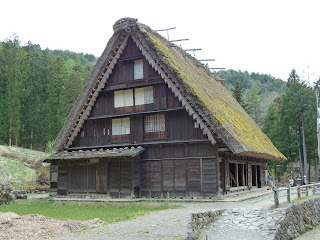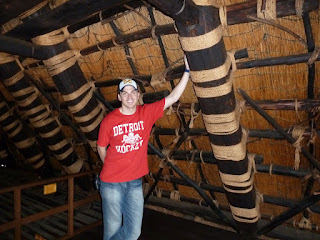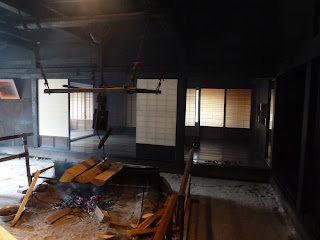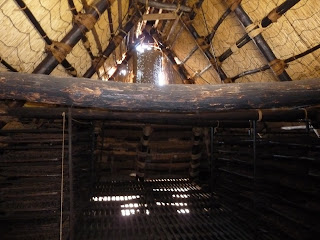After lunch we headed over to another section of Takayama called Hida-No-Sato, which is a Hida Folk Village. We visited a large open air museum, which consisted of dozens of traditional houses. These houses were dismantled at their original sites throughout the Hida region and rebuilt here.
There are two sections at the museum. The western section features 12 old houses and a complex of traditional buildings. The eastern section of the village is centered on Omoide Taikenkan, where you can try your hand at making traditional crafts. Here are a few pictures of our favorite homes.

Entrance of the museum. Across the pond is Nishioka's House, from the middle of the 1800's. This house has a typical Gassho-zukuri construction with a steep rafter roof. The word Gassho came from the shape of praying hands, which is similar to the shape of the roof.

Wakayama's House, from the middle of the 1700's. This is an old Japanese style house with a steep rafter roof. The ground floor was built by carpenters and the upper floors were constructed by the village people. It took the village people 4 days to make the thatched roof, which is said to last for 40-60 years.

Inside the house you could climb up to the top floor to see the roof of Yakamaya's House. Very impressive how they weaved the straw to create such an elaborate roof.

All of the homes had fire places, which were always lit. The smoke was very important for preserving the homes - the smoke protects it from harmful insects, keeps the straw and ropes tight, and gives the house moderate moisture.

Michikami's House, from the early 1800's. This is the style of a farmer's house from the northernmost area of Hida. When you look at the sides of this house you notice that it is different from others - the bottom of the roof was cut off. This is because people tried to get more sunlight into the house for the silkworm nursery on the upper floor.

We're standing on the third floor to see the roof of Michikami's House.
After visiting Hida-no-sato, we drove about 15 minutes outside of town to see the Garyu Cherry Tree, one of the largest cherry blossom trees in Japan. It's a state-designated natural monument. Garyu Cherry Tree literally means "The Lying-Dragon Cherry Tree," because the shape of the tree resembles a dragon lying on the ground. It's more than 1,100 years old, with branches 30 meters long and 20 meters high. It was spectacular! We missed the peak of it's bloom, but are so lucky to see it blooming at all.

After a fun filled afternoon, we went back into the city to have one more taste of Hida beef before we headed back to Nagoya. We choose a place called Suzuya, where you can grill your own beef over charcoal at the table. It had a great atmosphere, simple and clean interior with minimal decorations, a very true Japanese style. Food was pricey, but good!


I would love to visit here, and try the beef!
ReplyDeleteYou would LOVE it! It's very traditional looking, and you would enjoy sampling all the sake. :) We will definitely have to take you here!!
ReplyDeleteBefore rainy seaso(梅雨, つゆ, tsuyu), I highly recommend to visit Kamikouchi,上高地(かみこうち)in Nagano, where is like Yosemite national park in USA, although I have not been to Yosemite.
ReplyDeleteAnd nea Kamikouchi, there is Matsumoto Castle(松本城,まつもとじょう), which is origianak and national treasure, you'll like it. And try Soba-noodle served cold, " Zaru Soba", best Soba in Japan.
very cool - I already want to come back!
ReplyDelete